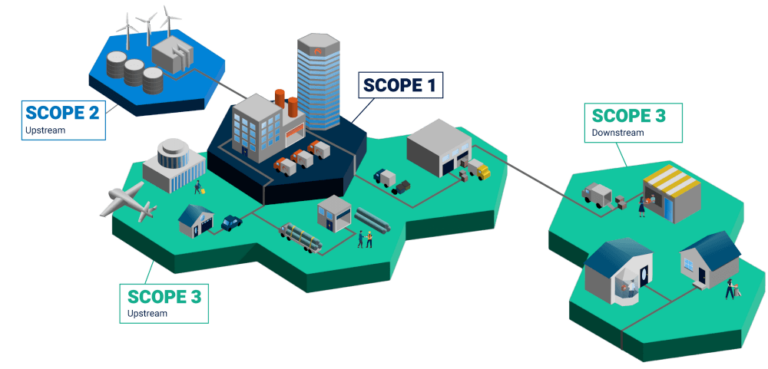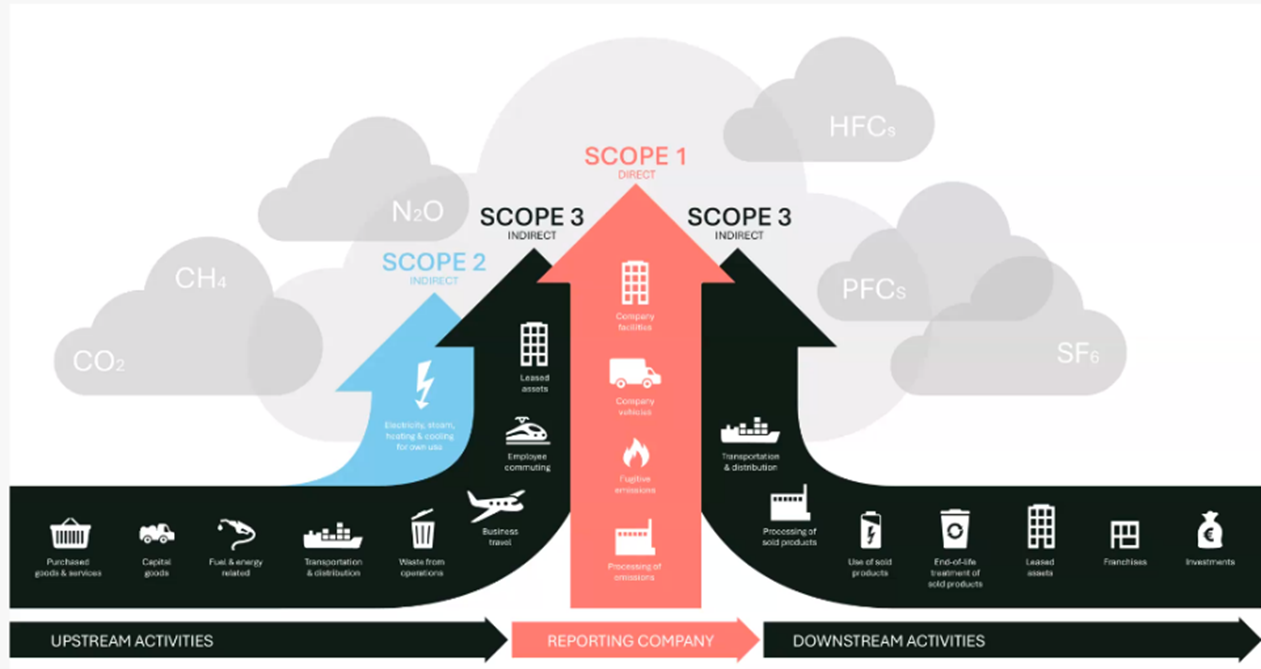
Contents
- Understanding Scope 1
- Understanding Scope 2
- Understanding Scope 3
- Why measure all three
- How Anthesis can help
Share this article
| Quick summary | |
|---|---|
| Scope 1 | Direct emissions from owned or controlled sources e.g., company vehicles, on-site fuel use |
| Scope 2 | Indirect emissions from purchased energy e.g., electricity, heating, or cooling |
| Scope 3 | Value-chain emissions from activities the company doesn’t control e.g., purchased goods, transport, business travel, product use and disposal |
Understanding GHG emissions and their scopes
At the heart of every decarbonisation journey lies the need to measure, understand, and track greenhouse gas (GHG) emissions. Before an organisation can set credible targets or implement effective climate solutions, it must first know where its emissions come from.
To standardise this process, the Greenhouse Gas (GHG) Protocol defines three categories—Scope 1, 2, and 3—that together account for all direct and indirect emissions linked to a company’s activities.

Scope 1 – direct emissions
Scope 1 emissions come from sources owned or controlled by an organisation. They are often the easiest to identify and measure.
Examples include:
- Fuel combustion in boilers, furnaces, or generators
- Emissions from company-owned vehicles
- Fugitive emissions, such as refrigerant leaks from cooling equipment
- Industrial process emissions (e.g., cement or steel production)
These emissions are under the company’s direct control and are typically the first to be addressed through efficiency upgrades or renewable energy adoption.
Scope 2 – indirect emissions from purchased energy
Scope 2 covers the indirect emissions generated by the production of purchased energy—such as electricity, heating, or cooling—that the organisation consumes.
Examples include:
- Purchased electricity for offices, factories, or data centres
- Purchased steam or district heating
- Chilled water used for cooling systems
Although these emissions occur at the energy supplier’s facility, they are attributed to the company that uses the energy. Transitioning to renewable energy contracts or on-site solar generation can significantly reduce Scope 2 impacts.
Scope 3 – other indirect emissions across the value chain
Scope 3 emissions encompass all other indirect emissions that occur outside an organisation’s direct control but within its value chain. These are often the largest and most complex to measure, representing upstream and downstream activities.
Upstream vs downstream emissions explained
Understanding the distinction between upstream and downstream activities is essential when assessing Scope 3 emissions:
- Upstream emissions occur before a product reaches your business—during material extraction, manufacturing, or inbound logistics.
- Downstream emissions occur after a product leaves your control—during customer use, distribution, and end-of-life.
A holistic view of both helps organisations target interventions at every stage of a product’s lifecycle.

Upstream examples
- Purchased goods and services
- Capital goods and raw material extraction
- Transportation and distribution of inputs
- Employee commuting and business travel
- Waste generated in operations
Downstream examples
- Distribution and delivery to customers
- Use of sold products
- End-of-life treatment, recycling, or disposal of products
- Investments and franchised operations
Measuring Scope 3 is challenging but critical for building a complete picture of corporate climate impact and for identifying opportunities to collaborate across the value chain.
Scope 3 emissions remain mostly voluntary to report, however, in most cases the reduction of Scope 3 has the potential to have the largest impact.
Why measure all three scopes?
While many organisations have ramped up their efforts to report on their carbon and energy emissions, there will continue to be an increase in the requirements associated with managing and auditing emissions. Frameworks such as the TCFD, SECR, and CSRD increasingly expect or require full value-chain reporting.
Reporting on Scope 1 and 2 is mandatory for many, whilst reporting emissions across the whole value chain will increasingly become harder to avoid.
Key benefits include:
- Transparent, science-based reporting that builds trust with investors and customers
- Identification of high-impact “hotspots” across the supply chain
- Lower energy and resource costs through efficiency improvements
- Enhanced readiness for future regulations
- Stronger reputation and leadership on climate action
Understanding and reporting across all three scopes also helps organisations align with Science-Based Targets and develop credible Net Zero roadmaps.

Measure your GHG emissions
Anthesis RouteZero – our comprehensive GHG inventory management solution -accelerates the pace with which organisations can assess their scope 1, 2 and 3 impact and develop actionable decarbonisation plans.
How Anthesis can help
Anthesis provides global expertise in measuring, analysing, and reducing Scope 1, 2, and 3 emissions.
Our team supports organisations in:
- Conducting GHG inventories and building robust data systems
- Identifying emission hotspots and value-chain reduction levers
- Developing Net Zero strategies and Science-Based Targets
- Ensuring compliance with frameworks like TCFD, SECR, and CSRD
- Enabling transparent disclosure and stakeholder reporting
Frequently Asked Questions
They are categories defined by the GHG Protocol to classify emissions as direct (Scope 1), indirect from purchased energy (Scope 2), and all other indirect value-chain emissions (Scope 3).
Scopes 1 and 2 are required under many national frameworks. Scope 3 is often voluntary but increasingly expected under global standards like CSRD and TCFD.
Because they typically account for 70–90% of a company’s total emissions footprint and offer the largest potential for systemic reductions.
Begin with a GHG inventory covering Scope 1 and 2, identify major Scope 3 categories, and partner with experts or tools like RouteZero to improve data quality and reporting consistency.



